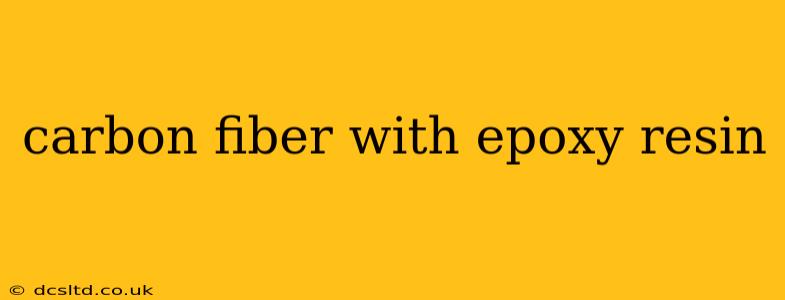Carbon fiber reinforced polymers (CFRP), commonly known as carbon fiber composites, are incredibly strong and lightweight materials made by combining carbon fibers with a resin matrix, most often epoxy resin. This combination results in a material with exceptional strength-to-weight ratio, making it ideal for a wide range of applications, from aerospace and automotive to sporting goods and construction. This guide delves into the intricacies of this powerful material pairing.
What is Epoxy Resin?
Epoxy resin is a thermosetting polymer, meaning it undergoes an irreversible chemical change when cured. This curing process, often initiated by a hardener, transforms the liquid resin into a solid, rigid matrix. Epoxy resins are chosen for carbon fiber composites due to their excellent adhesion to carbon fibers, high strength, and good chemical resistance. Different types of epoxy resins exist, each with varying properties tailored to specific applications. The selection of the epoxy resin is crucial to achieving the desired performance characteristics of the final composite.
How Carbon Fiber and Epoxy Resin are Combined
The process of combining carbon fiber and epoxy resin involves several key steps:
-
Preparation: The carbon fiber fabric or prepreg (pre-impregnated) material is carefully prepared. Prepreg simplifies the process as the resin is already applied to the fibers. For fabrics, the resin is applied in a controlled manner.
-
Layup: The carbon fiber layers are meticulously arranged according to a predetermined design. The orientation of the fibers significantly impacts the final strength and stiffness of the composite. This step requires precision to achieve the desired mechanical properties.
-
Curing: The layered composite is then cured, typically in an autoclave or oven under controlled temperature and pressure. This process allows the epoxy resin to fully cure, bonding the carbon fibers together and creating a solid, unified structure.
-
Post-Curing (Optional): Some applications require a post-curing process to further enhance the material’s properties, such as improving its resistance to heat or moisture.
What are the Advantages of Using Carbon Fiber with Epoxy Resin?
The synergy between carbon fiber and epoxy resin produces a composite material with numerous advantages:
-
High Strength-to-Weight Ratio: This is arguably the most significant advantage. Carbon fiber composites are exceptionally strong for their weight, making them ideal for applications where weight reduction is critical.
-
Stiffness: Carbon fiber composites exhibit high stiffness, meaning they resist deformation under load.
-
Durability: When properly manufactured, these composites are highly durable and resistant to damage.
-
Design Flexibility: The layering process allows for intricate designs and shapes to be created, tailoring the composite's properties to specific needs.
-
Chemical Resistance: Epoxy resins provide good chemical resistance, protecting the carbon fibers from environmental degradation.
What are the Disadvantages of Using Carbon Fiber with Epoxy Resin?
Despite its many advantages, carbon fiber composites with epoxy resin also have some limitations:
-
Cost: Carbon fiber and the manufacturing process are relatively expensive compared to other materials.
-
Manufacturing Complexity: Creating high-quality carbon fiber composites requires specialized equipment and skilled labor.
-
Brittleness: While strong, carbon fiber composites can be brittle and prone to cracking under impact or stress.
-
Susceptibility to UV Degradation: Prolonged exposure to ultraviolet (UV) radiation can degrade the epoxy resin over time.
What are the Applications of Carbon Fiber with Epoxy Resin?
The exceptional properties of carbon fiber epoxy composites make them suitable for a wide range of applications, including:
- Aerospace: Aircraft components, spacecraft structures.
- Automotive: High-performance car parts, lightweight body panels.
- Sporting Goods: Bicycle frames, fishing rods, tennis rackets.
- Construction: Reinforcement for concrete structures.
- Medical Devices: Prosthetics, implants.
How is the Strength of Carbon Fiber with Epoxy Resin Determined?
The strength of a carbon fiber/epoxy composite is influenced by numerous factors including:
-
Fiber Type and Orientation: The type of carbon fiber and its orientation within the composite significantly affect its strength and stiffness.
-
Resin Type and Quality: The choice of epoxy resin and its proper curing are critical for optimal performance.
-
Manufacturing Process: The layup procedure and curing conditions directly impact the final product's strength.
-
Fiber Volume Fraction: The proportion of carbon fiber in the composite also plays a crucial role in determining its overall strength.
What are Some Common Types of Epoxy Resins Used with Carbon Fiber?
Many epoxy resin systems are compatible with carbon fiber. The specific resin used depends on the application's requirements. Some common types include those offering high temperature resistance, enhanced toughness, or improved chemical resistance. Selecting the appropriate resin system is critical to optimizing the performance of the final carbon fiber composite.
This comprehensive guide provides a detailed overview of carbon fiber with epoxy resin, exploring its properties, advantages, disadvantages, and applications. Remember that the successful implementation of this material requires careful consideration of the various factors influencing its performance.
